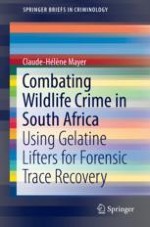2019 | OriginalPaper | Buchkapitel
3. Forensic Trace Recovery in Green Criminology
verfasst von : Claude-Hélène Mayer
Erschienen in: Combating Wildlife Crime in South Africa
Aktivieren Sie unsere intelligente Suche, um passende Fachinhalte oder Patente zu finden.
Wählen Sie Textabschnitte aus um mit Künstlicher Intelligenz passenden Patente zu finden. powered by
Markieren Sie Textabschnitte, um KI-gestützt weitere passende Inhalte zu finden. powered by
